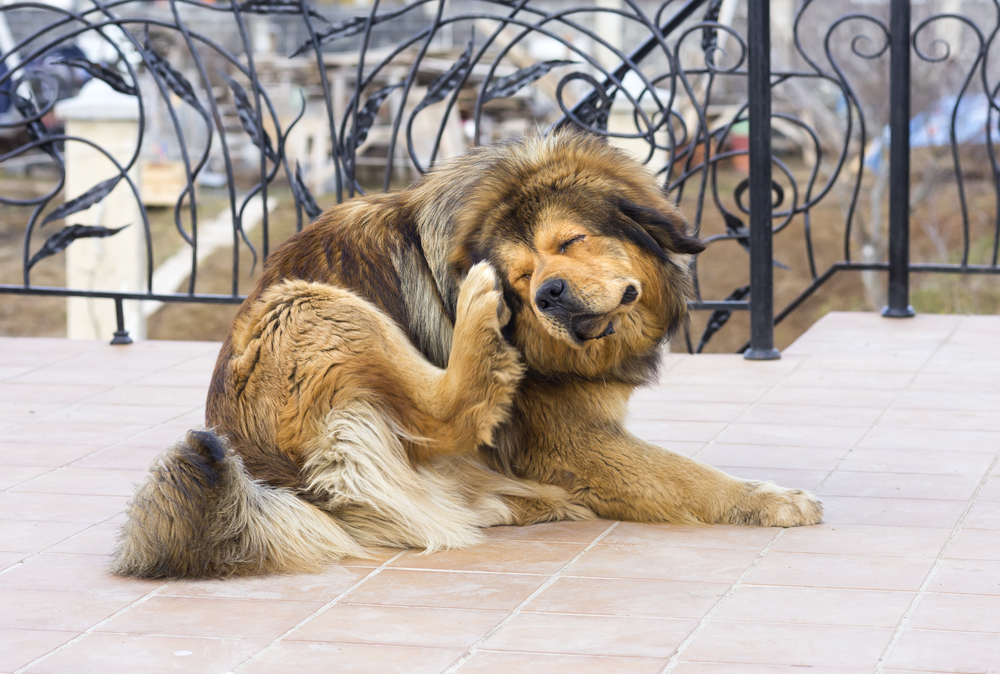Updated April 27, 2025
Fleas. The word alone is enough to make your skin crawl. So, how do you know if you’ve got a flea problem?
If your pets are itching like crazy or you’re finding bites on your own ankles, it’s time to put on your detective hat and hunt for the signs of fleas before things get worse. Grab your metaphorical magnifying glass. It’s time to do some serious sleuthing!
Why You Have Fleas in Your Home
If you’re seeing signs of fleas around your space, there’s a good chance your pets accidentally rolled out the red carpet for them. These opportunistic parasites easily grasp onto dog and cat fur, using them as unwitting vehicles for their indoor escapades.
But it’s not just our four-legged friends who provide a gateway for fleas. Fleas can cling to your clothing or shoes if you’ve wandered through an infested area. They can even sneak in on secondhand furniture, blankets, or pretty much anything that offers a little warmth and shelter.
Once inside, fleas waste no time setting up shop. A single female flea can lay hundreds of eggs in a matter of days. Those eggs fall right into your carpets, pet beds, and couch cushions, hatching into larvae before you’ve even spotted the first flea. Before you know it, you’ve got a full-blown flea-infested home.
Signs of Fleas on Your Pet & In Your Home
Have you ever noticed your furry friend acting slightly off lately, maybe scratching a little more than usual? It could be fleas. But how can you be sure? Here are nine unmistakable signs to keep an eye out for:
Sign #1: Excessive Scratching
One of the biggest red flags of fleas on animals is excessive scratching. If your dog or cat constantly scratches itself, especially around the head, neck, or tail, it could mean they’re trying to rid themselves of fleas. These pests love settling into hard-to-reach spots, making it tough for pets to groom them away.
While occasional scratching is normal, persistent scratching or biting should raise concerns. Monitor your pet’s behavior and note if it intensifies or becomes more frequent over time.
Sign #2: Rapid Hair Loss
Constant scratching and biting at flea bites can result in irritated skin and subsequent hair loss in affected areas.
Keep a close eye on your furry friend’s coat, paying particular attention to any sudden patches of baldness. If you notice bald spots appearing alongside increased scratching behavior, it could be a sign of fleas that need prompt attention.
Sign #3: Flea Dirt
Seeing tiny black specks on your pet’s fur or bedding? That’s probably flea dirt, a polite term for flea droppings made of digested blood. It looks like black pepper flakes and often gathers around the base of fur or in bedding.
To check for flea dirt, try the paper towel flea dirt test: Gently brush or rub your pet’s fur over a damp paper towel. If the specks turn reddish-brown when wet, that’s flea dirt. Time to act!
Sign #4: Red or Inflamed Skin
Flea bites can leave your pet’s skin red, inflamed, and seriously uncomfortable. If your pet’s skin is looking unusually irritated, or you spot raised red bumps, it could be a sign of fleas on your animal. Consult with your vet and schedule an examination if you notice any abnormalities or changes in your pet’s skin condition.
And don’t forget: if you’re going barefoot indoors and feel itchy red bites on your ankles, those fleas may be targeting you, too.
Sign #5: Restlessness or Agitation
Another sign of fleas indoors can relate to your pet’s demeanor. Dogs or cats struggling with fleas may appear agitated or unsettled, often accompanied by increased grooming behavior.
Monitor your pet’s behavior and note if they display any unusual behaviors or vocalizations that could indicate discomfort or distress. If they seem more on edge than usual, fleas might be making themselves at home on your furry friend.
Sign #6: Pale Gums
If fleas are left unchecked, their relentless biting can cause anemia, especially in smaller pets or those with weaker immune systems. An easy way to check? Look at your pet’s gums. If they seem pale or white, it’s a major sign of a flea infestation.
Anemia can be dangerous, so if you’re noticing pale gums along with other signs of fleas, get your pet to the vet as soon as possible.
Sign #7: Flea Bite Dermatitis
Flea bite dermatitis, a common skin condition caused by an allergic reaction to flea saliva, is another common sign of fleas. Pets with flea bite dermatitis may experience intense itching, redness, and skin lesions at the site of flea bites. Left untreated, the condition can worsen and even lead to secondary infections.
If you suspect your pet has flea bite dermatitis, seek veterinary care for diagnosis and treatment. Your vet can prescribe medications, recommend topical treatments, and provide supportive care to help manage your pet’s symptoms and prevent complications.
Sign #8: Visible Fleas
Want to know one of the easiest ways to know if you have fleas in your home? Sometimes, the most obvious answer is the correct one! If you’re dealing with a full-blown infestation, you may actually see fleas crawling around on your pet’s fur or bedding.
These tiny, reddish-brown insects are visible to the naked eye without the need for magnification. You may also come across flea eggs, tiny white or translucent bits that look like grains of salt.
Sign #9 Allergic Reactions
What exactly do flea bites feel like? Flea bites are generally mild, but you and your pets may develop allergic reactions to flea saliva, leading to symptoms such as excessive itching, redness, swelling, or even skin infections.
While severe reactions to fleas are rare, we recommend you contact your doctor or vet if the symptoms are not improving or worsening.
Eliminate Fleas in Washington & Oregon with Natura!
Are you noticing signs of fleas in your home? Turn to Natura, your top pest control expert in the Washington-Vancouver Metropolitan area. At Natura, we take a proactive approach to flea control to keep your home and yard pest-free. Our specialized treatments target fleas at the source, preventing infestations from taking hold and spreading.
Using a combination of outdoor barriers and granular yard treatments, we create a protective shield against fleas, stopping them in their tracks and eliminating breeding grounds.
Whether you’re noticing signs of fleas in your home or looking to prevent future outbreaks, we have the expertise and resources to ensure effective flea control and give you peace of mind for you and your pets.



